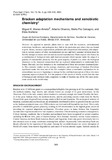Bracken adaptation mechanisms and xenobiotic chemistry.
Fecha
2005-07-01Palabras Clave
Grupo de Química EcológicaBracken, Pteridium, Xenobiotic, Adaptation
Metadatos
Mostrar el registro completo del ítemResumen
Bracken adaptation mechanisms and xenobiotic chemistry
(Alonso Amelot, Miguel; Oliveros, Alberto; Calcagno Pisarelli, María Pía and Arellano, Elida)
Abstract
As opposed to animals, plants have to cope with the resources, environmental restrictions, herbivores, and pathogens they find in the particular spot where they are bound to grow. Hence, resource sequestration, predation and competition relationships, and adaptation to various sources of other environmental stresses and their seasonal variation must be flexible enough to ensure survival and successful reproduction. Plants express this fitness by a combination of biological traits and chemical arsenals which operate under the reign of a genome of considerable plasticity. For the great majority of plants it is either the biological characters or the chemical composition that are explored independently to understand their fitness. But only in a few instances is the combination of these two avenues examined jointly. The extensive studies on the ecology, chemistry, and toxicology of bracken (Pteridium aquilinum) make this fern one of the few examples where a reasonable explanation for its extraordinary success is beginning to emerge by the combined perception of these two most important aspects of plant life. It is the purpose of this article to briefly review how the sum of biological and chemical traits cooperates to make of bracken one of the five most pernicious weeds in the world today.
© 2001 IUPAC
Pure Appl. Chem., Vol. 73, No. 3, pp. 549-553, 2001
Lecture presented at the 22nd IUPAC International Symposium on the Chemistry of Natural Products, São Carlos, Brazil, 3-8, September 2000. Other presentations are published in this issue, pp. 549-626.
Colecciones
Información Adicional
| Correo Electrónico | aloliver@ula.ve alonso@ula.ve mariapia@ula.ve |
| Editor | SABER ULA |






